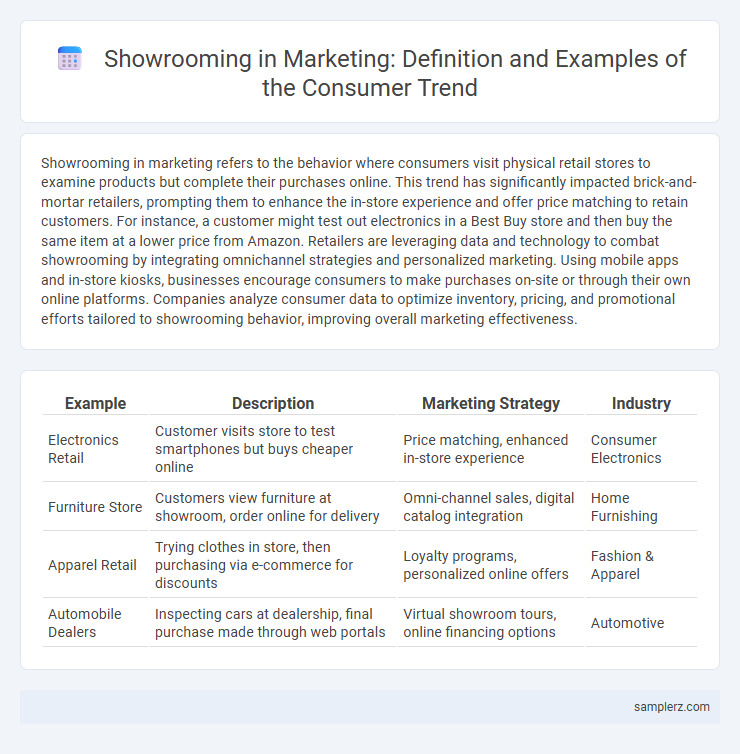Showrooming in marketing refers to the behavior where consumers visit physical retail stores to examine products but complete their purchases online. This trend has significantly impacted brick-and-mortar retailers, prompting them to enhance the in-store experience and offer price matching to retain customers. For instance, a customer might test out electronics in a Best Buy store and then buy the same item at a lower price from Amazon. Retailers are leveraging data and technology to combat showrooming by integrating omnichannel strategies and personalized marketing. Using mobile apps and in-store kiosks, businesses encourage consumers to make purchases on-site or through their own online platforms. Companies analyze consumer data to optimize inventory, pricing, and promotional efforts tailored to showrooming behavior, improving overall marketing effectiveness.
Table of Comparison
| Example | Description | Marketing Strategy | Industry |
|---|---|---|---|
| Electronics Retail | Customer visits store to test smartphones but buys cheaper online | Price matching, enhanced in-store experience | Consumer Electronics |
| Furniture Store | Customers view furniture at showroom, order online for delivery | Omni-channel sales, digital catalog integration | Home Furnishing |
| Apparel Retail | Trying clothes in store, then purchasing via e-commerce for discounts | Loyalty programs, personalized online offers | Fashion & Apparel |
| Automobile Dealers | Inspecting cars at dealership, final purchase made through web portals | Virtual showroom tours, online financing options | Automotive |
Understanding Showrooming: A Modern Consumer Behavior
Showrooming in marketing occurs when consumers visit a physical retail store to examine products before purchasing them online at a lower price or with better terms. Retailers use strategies like price matching, exclusive in-store promotions, and enhanced customer service to combat showrooming and retain sales. Understanding showrooming helps marketers tailor omnichannel experiences that integrate digital convenience with tactile store visits, boosting customer satisfaction and loyalty.
How Showrooming Impacts Retail Marketing Strategies
Showrooming significantly alters retail marketing strategies by driving retailers to enhance in-store experiences and integrate digital touchpoints to capture consumers who research products online before purchasing. Retailers invest in immersive displays, knowledgeable staff, and personalized services to transform brick-and-mortar locations into experiential hubs, countering the tendency of shoppers to buy online after viewing products in-store. Incorporating omnichannel marketing tactics, such as price matching and exclusive in-store promotions, helps retain customer loyalty and bridges the gap between offline browsing and online purchasing behaviors.
Real-World Example: Electronics Showrooming and Online Purchases
Consumers often visit electronics stores like Best Buy to physically examine products such as smartphones and laptops before purchasing them online at lower prices from retailers like Amazon. This behavior, known as showrooming, highlights the challenge traditional retailers face as customers leverage in-store experiences for information while completing transactions digitally. Retailers counter this trend by offering price-matching guarantees and enhancing in-store services to retain sales within their physical locations.
Fashion Industry: Showrooming Trends and Responses
Fashion industry retailers face significant showrooming challenges as consumers browse apparel collections in physical stores before purchasing online at lower prices. Brands counter showrooming by enhancing in-store experiences, integrating mobile apps for instant price matching, and offering exclusive in-store promotions that drive immediate sales. Emerging trends show the rise of omnichannel strategies combining digital and physical touchpoints to retain customer loyalty and increase purchase conversion rates.
The Role of Mobile Technology in Showrooming
Mobile technology plays a crucial role in showrooming by enabling consumers to compare prices, read reviews, and access product information instantly while shopping in physical stores. Smartphones equipped with barcode scanners and shopping apps empower shoppers to make informed purchasing decisions on the spot or opt for online alternatives. Retailers integrate mobile-friendly features such as augmented reality and personalized promotions to enhance the in-store experience and compete effectively against e-commerce platforms.
How Brands Combat Showrooming with Omnichannel Marketing
Brands combat showrooming by integrating seamless omnichannel marketing strategies that unify in-store and online experiences, enabling customers to browse products physically while completing purchases digitally. They utilize personalized promotions, real-time inventory updates, and mobile apps to encourage online-to-offline conversions, enhancing customer engagement across multiple touchpoints. Leveraging data analytics, brands optimize targeted advertising and tailor communications to drive loyalty and reduce the customer's tendency to switch channels without purchasing.
Case Study: Showrooming in Furniture Retail
Showrooming in furniture retail occurs when customers visit physical stores to experience products like sofas and dining sets before purchasing them online at lower prices. A notable case study involves IKEA, where shoppers evaluate product quality and comfort in-store but finalize orders on cost-comparison websites or the retailer's e-commerce platform. This behavior challenges traditional sales models, prompting furniture retailers to integrate digital channels and enhance in-store experiences to retain customer loyalty.
Best Practices for Marketers to Address Showrooming
Retailers should enhance the in-store experience by integrating augmented reality tools and personalized customer service to compete with online convenience. Implementing price-matching guarantees and exclusive in-store promotions can incentivize immediate purchases and reduce customer loss to e-commerce platforms. Leveraging data analytics to understand showrooming behavior enables targeted marketing campaigns that align with consumer online research patterns.
Leveraging In-Store Experience to Reduce Showrooming
Retailers combat showrooming by enhancing in-store experiences with interactive product demonstrations and personalized customer service, encouraging immediate purchases. Integration of augmented reality displays allows shoppers to visualize products in real-life settings, increasing engagement and conversion rates. Leveraging loyalty programs tied to in-store visits further incentivizes customers to complete transactions on-site rather than online.
Future Trends: Adapting Marketing to the Rise of Showrooming
Retailers must integrate advanced digital tools and personalized mobile experiences to counter showrooming, where consumers examine products in-store but purchase online. Leveraging augmented reality and AI-driven recommendations enhances in-store engagement while capturing valuable consumer data for targeted marketing. Future marketing strategies will prioritize seamless omnichannel integration, blending physical and digital touchpoints to meet evolving consumer behaviors shaped by showrooming trends.

example of showrooming in marketing Infographic
 samplerz.com
samplerz.com